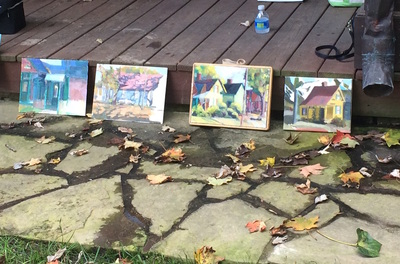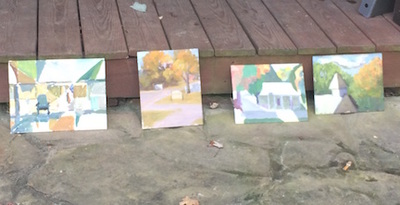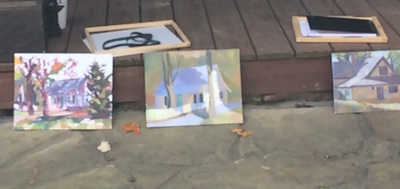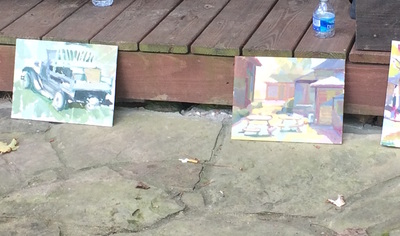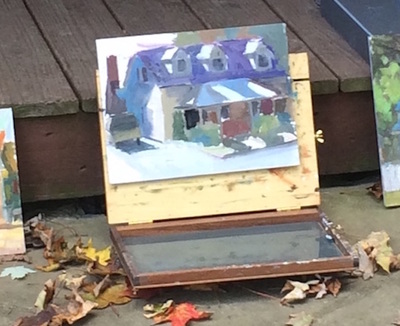|
The few days post-workshop are a lot like jet lag! It's crazy how tired my brain gets and the silly little squabbles my left brain has with my right brain. Art is funny in that way because you really do have to use both the analytical, decision making brain AND the nonverbal, intuitive brain to create a successful painting. So, here I am attempting with words and symbols to create a picture for you, dear readers, of what Kevin, a tremendously successful and very popular American oil painter, taught us last week.
There are three key ingredients that make up a good painting: light & shadow, abstract shapes, and color. Of course, there are about 50 more ingredients that help out, but without these three the results will disappoint. Another word for light & shadow is "value" and the artist uses a value scale of 1-10 to decide how dark or light a particular color mixture is. Squinting is the happy habit of the painter. Try it yourself: take a moment to look at the room you're in, now squint your eyes until what you see is reduced to only dark and light. This is the beginning of a painting composition! It's a very flat plane of abstract light shapes and shadow shapes. Some of the dark that you see are recognizable objects, like a chair or lamp, but you are also seeing the cast shadow and the form shadow of the object which gets included in the overall dark shape. Now it's not a chair. It's an abstract area of dark. If you sketch that shape out on paper and put in the other dark shapes you see in the room, leaving the light areas alone, the result will be a simplified value sketch, a roadmap to follow as you begin your painting. Kevin emphasized how important it is to understand that every color (and there are so many!) in the shadow areas must be painted a darker value than anything that is in the light. Sounds simple, but this is where ms. left brain and ms. right brain wanted to mud wrestle in my head. Not only was SEEING and IDENTIFYING the lightest "shadow" crazy difficult, but REMEMBERING that the lightest color value in the shadow still had to be darker than the darkest color value in the light area. Try saying that to yourself 10 times! We 20 brave students gave our best efforts in the mid-80's autumn sunshine of Tennessee and by our third painting we all passed the bar!
6 Comments
Betty
10/24/2016 02:16:50 pm
You make me want to try! Your explanations of your various workshops and lessons are so clear...It must help keep them in your frontal lobe to teach them to us. you're amazing!
Reply
Wendy
10/25/2016 03:16:20 pm
Whew! Thank goodness it made some sort of sense! And, oh yes! do try! How fun would that be?? Painting together around the world!
Reply
Kathleen
10/24/2016 03:37:05 pm
Unlike Betty, my befuddled brain hurt after I read all you have to know to paint like you do! This makes me all the more impressed with your talent!! 😍
Reply
Wendy
10/25/2016 03:17:55 pm
I can relate to befuddlement 😜 I claim passion over talent...that's what keeps me going!
Reply
Robin Raymond
11/10/2016 07:42:14 am
Wendy,
Reply
Wendy
11/10/2016 06:47:39 pm
You definitely will be going places with your art! Your passion and enthusiasm shows, my friend! Thank you always for your kind words😉
Reply
Leave a Reply. |
Hello! My name is Wendy and I am passionate about oil painting! Whether in the studio or out in Mother Nature, I get lost in the experience of capturing on canvas the moment and the feel of what I am painting. I pour my love and energy into every single piece of artwork and I hope it shows! This blog is a place where I can use words to talk about art, painting, life, faith, things that make me laugh, and things that inspire. I love every response, so don't be shy about leaving a comment...Archives
June 2024
Categories |
